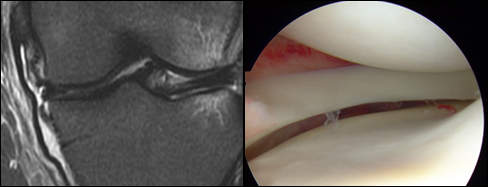ACL and medial-sided injuries: When should we fix the medial side?
ACL and medial collateral ligament injuries are a relatively common injury we see with contact and collision sports. However, objective completely defined criteria for fixing the medial side in addition to the ACL remain controversial and not set in stone.
One must fully understand the anatomy of the medial side as well as appreciate the subtle exam findings of a combined ACL/medial collateral ligament injuries (MCL) injury. The majority of these cases involving the MCL only involve the superficial MCL (often the femoral side and not a tibial avulsion). The important deep fibers of the MCL that anchor the meniscus to the tibia and femur as well as the posterior oblique ligament (POL) are spared.
Define the injury pattern
This medial-sided injury often heels with conservative treatment prior to the surgery for the ACL reconstruction. A minority of these medial-sided injuries involve the entire MCL, including the deep fibers attached to the meniscus as well as the POL. These are the ones that, if left untreated, can dramatically affect the results of ACL reconstruction in a negative manner. Physical exam findings of this combined high-energy injury are that the knee will often open medially in full extension compared with the opposite knee and will open completely at 30% of flexion with very little endpoint. MRI will help define where the lesion is located, i.e., femoral or tibial based, and will show the involvement of the POL, which is posterior to the MCL. It is important to define the injury pattern at the time of the arthroscopy with the presence of an arthroscopic drive-through sign, which confirms the medial-sided injury and its predominate location. The meniscus will tell exactly where the injury is located.

MRI shows high-energy medial sided injury with tibial avulsion of the superficial MCL, complete disruption of the deep MCL and its attachment to the medial meniscus. Scope photo shows opening of the medial compartment with minimal valgus stress. Note how the medial meniscus has followed the femur and is “free floating” off of the tibia in this combined ACL/MCL injury in this female soccer player, knee vs goalie.
Source: Johnson DL
If the meniscus stays with the femur in valgus stress and lifts off the tibia, which is more common, then you have a tibial-sided lesion. If the meniscus stays with the tibia and the gap is seen above the meniscus, then you have a femoral-sided lesion. This is important to visualize to confirm the MRI findings and planned surgical approaches. Repair of these lesions within the first 3 weeks of injury allows for anatomic repair of all medial support structures, including the superficial and deep MCL as well as the important POL ligament at the posteromedial corner.
Careful evaluation
In summary, one must carefully examine the medial side, review critically the MRI of the medial-sided injury and confirm all of the above with their eyes during the medial-sided evaluation with the scope in the medial compartment. The arthroscopic drive-through sign is of paramount importance in these injuries.
During the past 20 years, I fully appreciate the anatomy of these lesions and combined treatment. Surgical repair of these lesions acutely has been rewarding while the treatment of these medial lesions in the chronic setting is exceedingly more difficult with less optimal outcomes.
